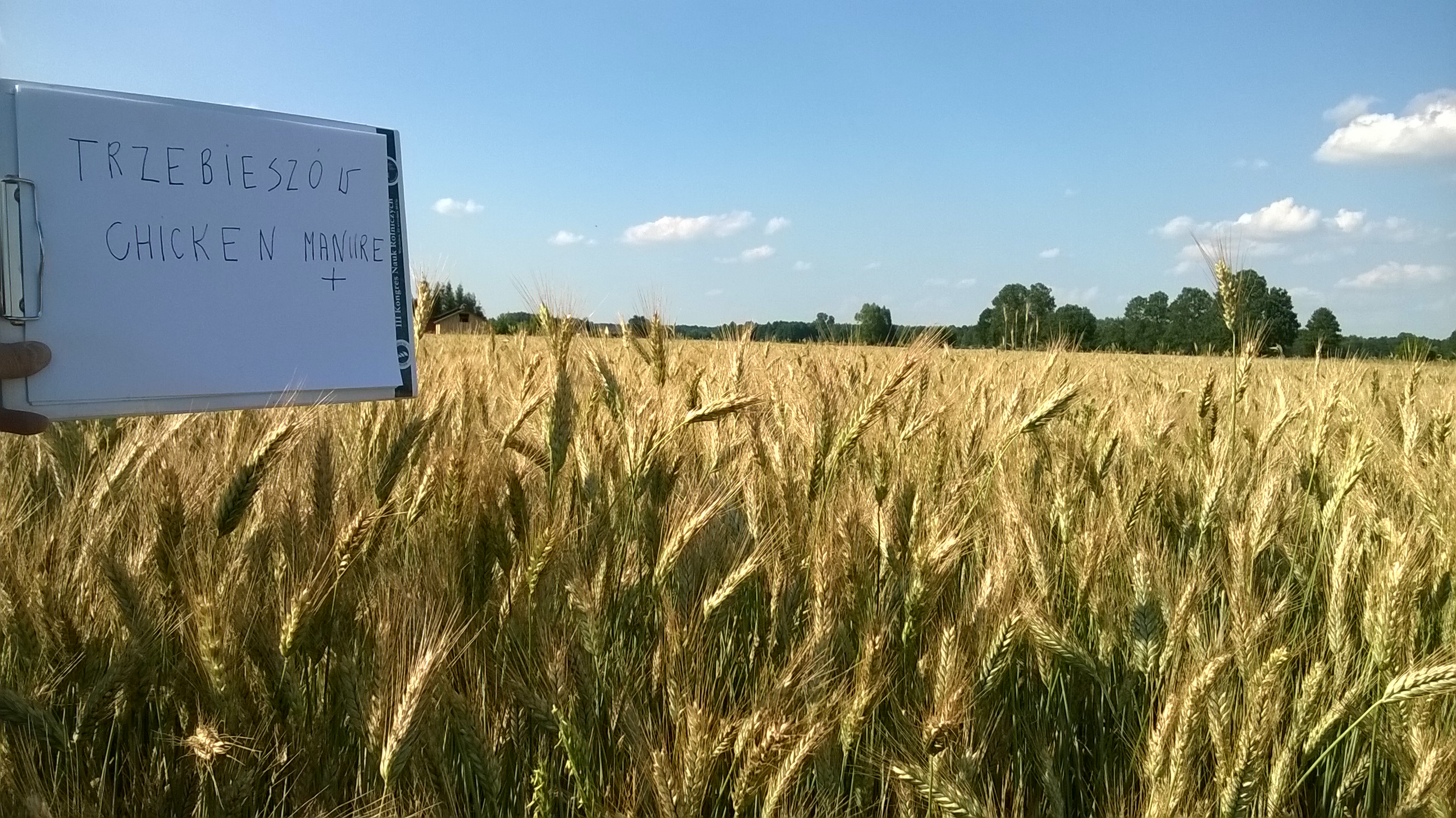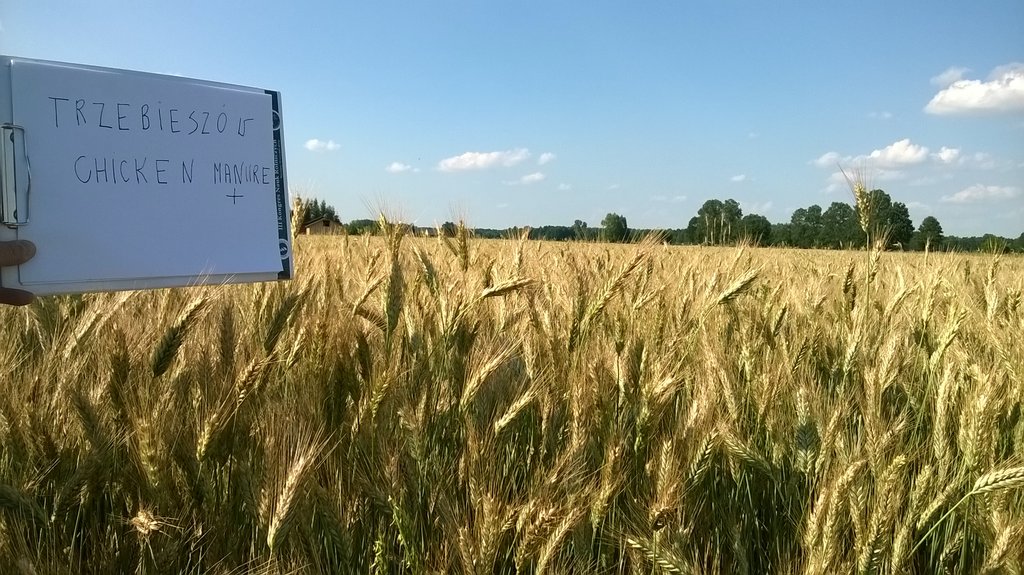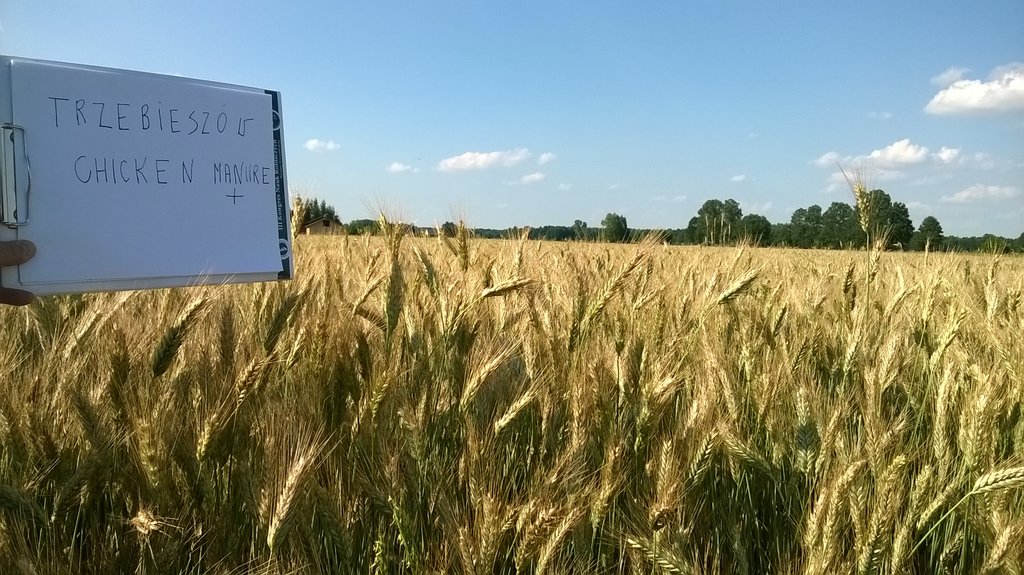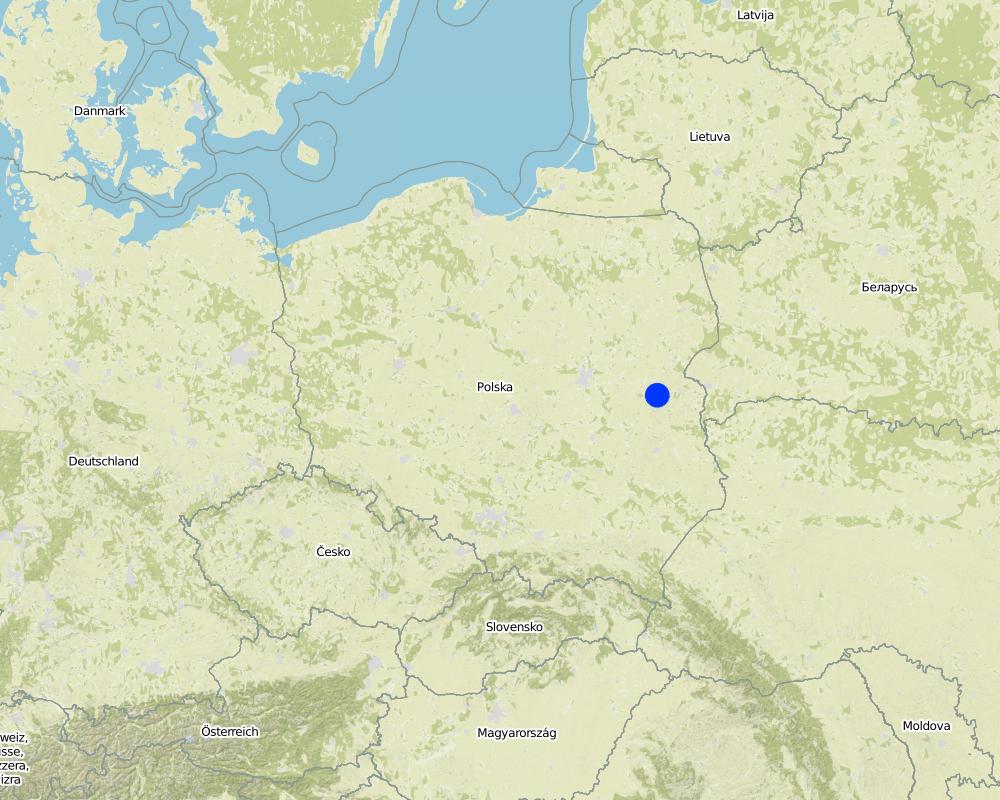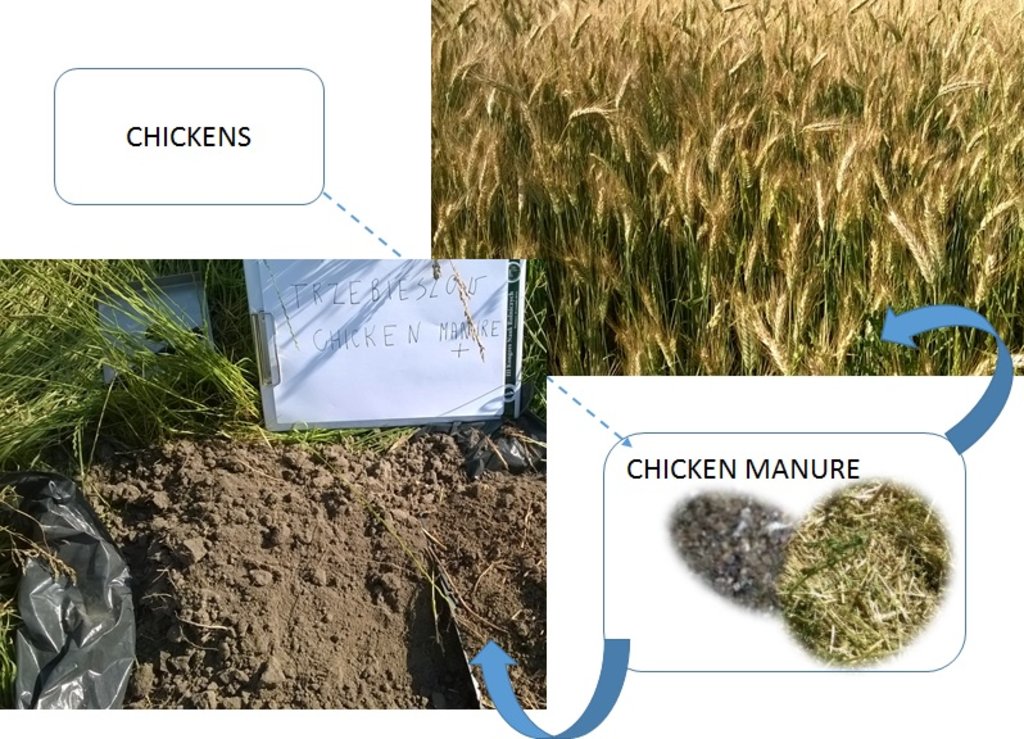Chicken manure in non irrigated arable land [Poland]
- Creation:
- Update:
- Compiler: Magdalena Frac
- Editor: –
- Reviewers: Ursula Gaemperli, Gudrun Schwilch
Manuring & composting
technologies_2848 - Poland
View sections
Expand all Collapse all1. General information
1.2 Contact details of resource persons and institutions involved in the assessment and documentation of the Technology
Lipiec Jerzy
j.lipiec@ipan.lublin.pl
Institute of Agrophysics, Polish Academy of Sciences
Doswiadczalna 4, 20-290 Lublin
Poland
Usowicz Bogusław
m.frac@ipan.lublin.pl
Institute of Agrophysics, Polish Academy of Sciences
Doswiadczalna 4, 20-290 Lublin
Poland
Name of project which facilitated the documentation/ evaluation of the Technology (if relevant)
Interactive Soil Quality assessment in Europe and China for Agricultural productivity and Environmental Resilience (EU-iSQAPER)Name of the institution(s) which facilitated the documentation/ evaluation of the Technology (if relevant)
Institute of Agrophysics, Polish Academy of Sciences (IA PAS) - Poland1.3 Conditions regarding the use of data documented through WOCAT
When were the data compiled (in the field)?
29/06/2016
The compiler and key resource person(s) accept the conditions regarding the use of data documented through WOCAT:
Yes
1.4 Declaration on sustainability of the described Technology
Is the Technology described here problematic with regard to land degradation, so that it cannot be declared a sustainable land management technology?
No
2. Description of the SLM Technology
2.1 Short description of the Technology
Definition of the Technology:
Manuring and composting - amendment with chicken manure.
Chicken manure as organic matter derived from animal (chicken), which can be used as organic fertilizer in agriculture.
2.2 Detailed description of the Technology
Description:
The technology is used in Trzebieszów (N 51.990203; E 22.59253), in Podlasie Region in Poland under cereals or oil crops. The technology is used on about 2 ha area. The case study is embedded in typical agricultural region on rather fertile soils formed from loess. The altitude in the study site is 153 m.a.s.l., average temperature 7.1°C and precipitation 550 mm. Chicken manure is used for more than 20 years (10 t/ha) on non irrigated arable land. Chickens are hold in Podlasie Region. Land user already hold chickens before the implementation of the Technology. Chicken manure is organic matter derived from animals (chicken), which can be used as organic fertilizer in agriculture. Chicken manure is high in organic matter making it desirable for use as a soil amendment or soil conditioner. It contributes to the fertility of the soil by adding organic matter and is nutritionally rich. It has the highest amount of nitrogen, phosphorus, and potassium. Chicken manure can improve soil structure and impacts microbiological activity and plant growth. The field should be ploughed and harrowed once with a tractor after which a uniform rate of 10 t/ha of chicken manure is applied. One chicken produces about 150g of chicken manure per day. The farmers mix the chicken manure with straw. In majority the use of chicken manure as fertilizer increases the yield of the crops. It is necessary to control a level of nutrients in the soil. A further benefit from the Technology is the reduction of chemical fertilizers which has positive effects concerning the costs. Moreover, if chicken manure comes from the own farm the combination with the Technology closes the nitrogen cycle on the farm.
2.3 Photos of the Technology
2.5 Country/ region/ locations where the Technology has been applied and which are covered by this assessment
Country:
Poland
Region/ State/ Province:
Podlasie
Further specification of location:
Trzebieszów
Comments:
Trzebieszów, Podlasie, Poland. Coordinates: N 51.99020; E 22.59253
Map
×2.6 Date of implementation
If precise year is not known, indicate approximate date:
- 10-50 years ago
2.7 Introduction of the Technology
Specify how the Technology was introduced:
- through land users' innovation
3. Classification of the SLM Technology
3.1 Main purpose(s) of the Technology
- improve production
- reduce, prevent, restore land degradation
- preserve/ improve biodiversity
- reduce risk of disasters
- create beneficial economic impact
3.2 Current land use type(s) where the Technology is applied

Cropland
- Annual cropping
Main crops (cash and food crops):
cereals, especially triticale, oat and wheat
3.3 Further information about land use
Water supply for the land on which the Technology is applied:
- rainfed
Number of growing seasons per year:
- 1
3.4 SLM group to which the Technology belongs
- integrated soil fertility management
3.5 Spread of the Technology
Specify the spread of the Technology:
- evenly spread over an area
If the Technology is evenly spread over an area, indicate approximate area covered:
- < 0.1 km2 (10 ha)
Comments:
Chicken manure production, near the chicken farms.
3.6 SLM measures comprising the Technology

agronomic measures
- A2: Organic matter/ soil fertility
3.7 Main types of land degradation addressed by the Technology

physical soil deterioration
- Pc: compaction
- Pk: slaking and crusting

biological degradation
- Bq: quantity/ biomass decline
- Bl: loss of soil life
3.8 Prevention, reduction, or restoration of land degradation
Specify the goal of the Technology with regard to land degradation:
- prevent land degradation
4. Technical specifications, implementation activities, inputs, and costs
4.1 Technical drawing of the Technology
4.2 Technical specifications/ explanations of technical drawing
The utilization of chicken manure as an organic fertilizer is essential to improve the soil productivity and the crop production. The field should be ploughed and harrowed once with a tractor after which a uniform rate of 10 t/ha of chicken manure is applied. One chicken produces about 150g of chicken manure per day. The farmers mix the chicken manure with straw.
4.3 General information regarding the calculation of inputs and costs
Specify how costs and inputs were calculated:
- per Technology area
Indicate size and area unit:
1 ha
other/ national currency (specify):
PLN
Indicate exchange rate from USD to local currency (if relevant): 1 USD =:
0.28
Indicate average wage cost of hired labour per day:
50-100 PLN
4.4 Establishment activities
| Activity | Type of measure | Timing | |
|---|---|---|---|
| 1. | Purchase of polutry | Management | Spring, Summer, Autumn |
| 2. | Chicken coop construction | Management | Spring, Summer, Autumn |
| 3. | Buy of hens and cock | Management | Spring, Summer, Autumn |
| 4. | Construction of manure storage facility | Management | Spring, Summer, Autumn |
4.5 Costs and inputs needed for establishment
If possible, break down the costs of establishment according to the following table, specifying inputs and costs per input. If you are unable to break down the costs, give an estimation of the total costs of establishing the Technology:
600.0
4.6 Maintenance/ recurrent activities
| Activity | Type of measure | Timing/ frequency | |
|---|---|---|---|
| 1. | Mixing of chicken manure with straw | Agronomic | Autumn |
| 2. | Chicken manure application | Agronomic | Autumn |
4.7 Costs and inputs needed for maintenance/ recurrent activities (per year)
If possible, break down the costs of maintenance according to the following table, specifying inputs and costs per input. If you are unable to break down the costs, give an estimation of the total costs of maintaining the Technology:
300.0
4.8 Most important factors affecting the costs
Describe the most determinate factors affecting the costs:
Pesticides, mineral fertilization, seed, fuel
5. Natural and human environment
5.1 Climate
Annual rainfall
- < 250 mm
- 251-500 mm
- 501-750 mm
- 751-1,000 mm
- 1,001-1,500 mm
- 1,501-2,000 mm
- 2,001-3,000 mm
- 3,001-4,000 mm
- > 4,000 mm
Agro-climatic zone
- sub-humid
5.2 Topography
Slopes on average:
- flat (0-2%)
- gentle (3-5%)
- moderate (6-10%)
- rolling (11-15%)
- hilly (16-30%)
- steep (31-60%)
- very steep (>60%)
Landforms:
- plateau/plains
- ridges
- mountain slopes
- hill slopes
- footslopes
- valley floors
Altitudinal zone:
- 0-100 m a.s.l.
- 101-500 m a.s.l.
- 501-1,000 m a.s.l.
- 1,001-1,500 m a.s.l.
- 1,501-2,000 m a.s.l.
- 2,001-2,500 m a.s.l.
- 2,501-3,000 m a.s.l.
- 3,001-4,000 m a.s.l.
- > 4,000 m a.s.l.
5.3 Soils
Soil depth on average:
- very shallow (0-20 cm)
- shallow (21-50 cm)
- moderately deep (51-80 cm)
- deep (81-120 cm)
- very deep (> 120 cm)
Soil texture (topsoil):
- coarse/ light (sandy)
Topsoil organic matter:
- medium (1-3%)
5.4 Water availability and quality
Ground water table:
5-50 m
Availability of surface water:
poor/ none
Water quality (untreated):
good drinking water
Is water salinity a problem?
No
Is flooding of the area occurring?
No
5.5 Biodiversity
Species diversity:
- medium
Habitat diversity:
- medium
5.6 Characteristics of land users applying the Technology
Sedentary or nomadic:
- Sedentary
Market orientation of production system:
- commercial/ market
Off-farm income:
- less than 10% of all income
Relative level of wealth:
- average
Individuals or groups:
- individual/ household
Level of mechanization:
- mechanized/ motorized
Gender:
- women
Age of land users:
- middle-aged
5.7 Average area of land owned or leased by land users applying the Technology
- < 0.5 ha
- 0.5-1 ha
- 1-2 ha
- 2-5 ha
- 5-15 ha
- 15-50 ha
- 50-100 ha
- 100-500 ha
- 500-1,000 ha
- 1,000-10,000 ha
- > 10,000 ha
Is this considered small-, medium- or large-scale (referring to local context)?
- medium-scale
5.8 Land ownership, land use rights, and water use rights
- family
Land use rights:
- individual
5.9 Access to services and infrastructure
health:
- poor
- moderate
- good
education:
- poor
- moderate
- good
technical assistance:
- poor
- moderate
- good
employment (e.g. off-farm):
- poor
- moderate
- good
markets:
- poor
- moderate
- good
energy:
- poor
- moderate
- good
roads and transport:
- poor
- moderate
- good
drinking water and sanitation:
- poor
- moderate
- good
financial services:
- poor
- moderate
- good
6. Impacts and concluding statements
6.1 On-site impacts the Technology has shown
Socio-economic impacts
Production
crop production
Comments/ specify:
The farmer observed increase of crop productivity in Mg per ha for cereales. Grain yield of wheat under chicken manure application vary from 4.5 to 6.5 t/ha.
crop quality
Comments/ specify:
The chicken manuring technology increases crop quality by improving soil water realtions.
risk of production failure
Comments/ specify:
The chicken manuring technology decreases the risk of production failure due to greater yield stability.
land management
Comments/ specify:
The chicken manuring technology simplifies land management by less intense machinery use.
Income and costs
expenses on agricultural inputs
Comments/ specify:
The expenses on agricultural inputs in chicken manuring technology are reduced due to lower mineral fertilizers costs.
Socio-cultural impacts
food security/ self-sufficiency
Comments/ specify:
The chicken manuring technology improves the food security by increased yield stability.
SLM/ land degradation knowledge
Comments/ specify:
Land degradation knowledge is improved by the promotion of the chicken manuring technology.
Ecological impacts
Water cycle/ runoff
water quantity
Comments/ specify:
The water quantity increases in chicken manuring technology due to less evaporation caused by better water relations after organic matter incorporation into the soil. The technology improves water retention.
harvesting/ collection of water
Comments/ specify:
The water collection in chicken manuring technology is improved due to better infiltration of rainfall water through earthworms macropores open at the soil surface.
surface runoff
Comments/ specify:
The surface runoff in chicken manuring technology decreased due to presence of higher content of organic matter and open earthworms macropores increasing infiltration of rainfall water.
Soil
soil moisture
Comments/ specify:
The chicken manuring technology increases soil moisture by reduced evaporation due to increasing soil organic matter content.
soil organic matter/ below ground C
Comments/ specify:
The chicken manuring technology increases soil organic matter content due to incorporation of exogenous organic matter into the soil.
Biodiversity: vegetation, animals
biomass/ above ground C
Comments/ specify:
The farmer observed increase of crop productivity.
Climate and disaster risk reduction
drought impacts
Comments/ specify:
The technology decreases drought impacts by increasing the soil organic matter content.
6.3 Exposure and sensitivity of the Technology to gradual climate change and climate-related extremes/ disasters (as perceived by land users)
Climate-related extremes (disasters)
Climatological disasters
| How does the Technology cope with it? | |
|---|---|
| drought | well |
Comments:
The technology decreases drought impacts by increasing the soil organic matter content.
6.4 Cost-benefit analysis
How do the benefits compare with the establishment costs (from land users’ perspective)?
Short-term returns:
slightly negative
Long-term returns:
positive
How do the benefits compare with the maintenance/ recurrent costs (from land users' perspective)?
Short-term returns:
positive
Long-term returns:
positive
Comments:
At the beginning the slightly negative cost-benefit is conected with the cost of polutry purchase and the construction of needed facility.
6.5 Adoption of the Technology
- 1-10%
If available, quantify (no. of households and/ or area covered):
about 2 ha
Of all those who have adopted the Technology, how many have did so spontaneously, i.e. without receiving any material incentives/ payments?
- 90-100%
6.7 Strengths/ advantages/ opportunities of the Technology
| Strengths/ advantages/ opportunities in the land user’s view |
|---|
| Positive impact on the level of organic matter in the soil. Saving money because of the lower costs of chicken manure, which is used instead of mineral fertiliser. |
| Strengths/ advantages/ opportunities in the compiler’s or other key resource person’s view |
|---|
| Positive impact on the level of organic matter in the soil. |
| Positive influence on soil quality including structure, porosity and infiltration rate. |
6.8 Weaknesses/ disadvantages/ risks of the Technology and ways of overcoming them
| Weaknesses/ disadvantages/ risks in the land user’s view | How can they be overcome? |
|---|---|
| High level of NPK in chicken manure. | Monitoring of NPK in chicken manure and soil. |
| Weaknesses/ disadvantages/ risks in the compiler’s or other key resource person’s view | How can they be overcome? |
|---|---|
| High level of NPK in chicken manure. | Monitoring of NPK in chicken manure and soil. |
7. References and links
7.1 Methods/ sources of information
- field visits, field surveys
2
- interviews with land users
2
- compilation from reports and other existing documentation
3
Links and modules
Expand all Collapse allLinks
No links
Modules
No modules


